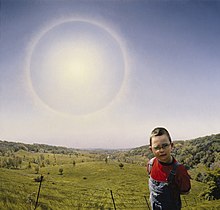David Lenz
American painter
David Lenz (born 14 August 1962) is an American painter.

| This article about an artist is a stub. You can help out with Wikiquote by expanding it! |
Quotes
edit- In America today, perfection is highly valued. We dump loads of chemicals on our lawns to try and get rid of every weed, every dandelion. Models and supermodels are tall, impossibly fit, their clothes stylish and wrinkle-free. Images like this tend to change our perceptions, our ideals, until finally they leave us looking around at the peeling paint on our own houses, and our less than fit bodies, and it leaves us wanting.
Perfection, I would submit, is overrated. And besides, I like dandelions.
In the painting Sam assumes the role of presenter, host, even tutor, of this most revealing examination of the civilization man has made for himself. Sam is not society's accepted definition of perfection. In spite of that, or perhaps because of that, he really does have an important message for everyone to hear.- Statement regarding his painting Sam and the Perfect World (2005), as quoted in "Exhibition Finalists" for the National Portrait Gallery's first Outwin Boochever Portrait Competition in 2006.
Quotes about Lenz
edit- The rise of the selfie is an especially big deal when considering how artists push away from it, a theme that unifies the past three winners. Each challenges the nature of subjectivity to move ultimately beyond the self to a more universal view of the subject, especially in relation to the artist and to the viewer and within the context of the history of portraiture.
In 2006, David Lenz oil on linen portrait of his son, entitled Sam and the Perfect World depicts a child with Down Syndrome. For Lenz, this was the "most personal painting" he’d ever done. "It touches on all the various issues that challenge our family," he said. Without a hint of idealization or sentimentality, and without crossing the threshold into dramatizing the complex father-son relationship captured here, Sam is shown posed in front of a barbed wire fence. A bucolic country landscape with a pulsing sun reverberating in the pale blue sky proves the backdrop for a young boy wearing glasses and leaning toward the viewer with his brow slightly furrowed and his arms behind his back. Is he hiding something? Or trying to tell us something? There is something inscrutable and endearing about his expression that makes us want to spend time with him. In his red T-shirt and Oshkosh overalls he is in some ways a classic little boy. And yet he is not. As Lenz says, "Sam is the opposite of the idealized 'perfect" countryside. Nevertheless, I think he has something very important to say." Remniscent of Charles Willson Peale’s The Artist in His Museum (1822), Lenz has crafted a masterful composition with extraordinary technical skill.
External links
edit- "Mural pays homage to the bravery of children with illnesses." by James Auer, Milwaukee Journal Sentinel (20 September 2000)
- "Looking History in the Eye at Portrait Gallery" by Lynn Neary, National Public Radio: Talk of the Nation, (13 July 2006)
- "Commentary: Sam and the Perfect World" by Barry Bub, Medicine Academic Vol. 82, Issue 2 (February 2007)
- "Behind the Brush: Realist Painter David Lenz Finds a Rural Wonderland in Sauk County" by Gayle Worland, Wisconsin State Journal (22 April 2007)
- "Eunice Kennedy Shriver" (2009), a portrait commissioned by the National Portrait Gallery, upon winning the NPG's first Outwin Boochever Portrait Competition in 2006.